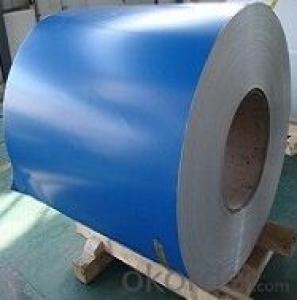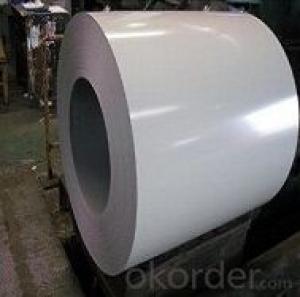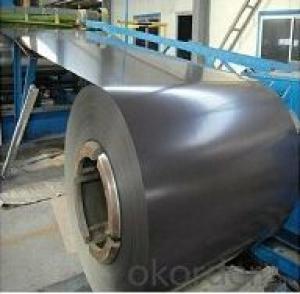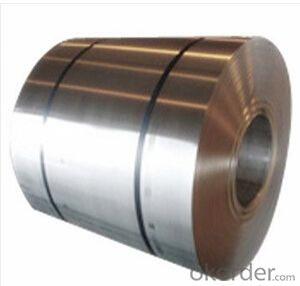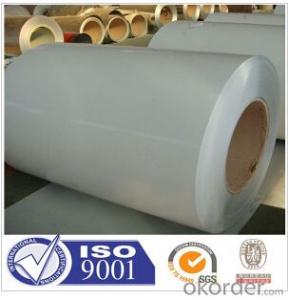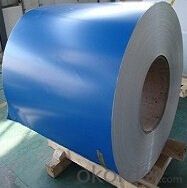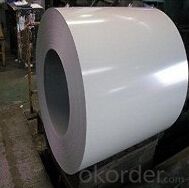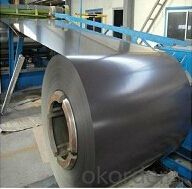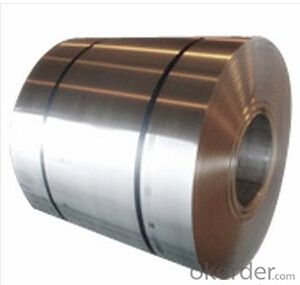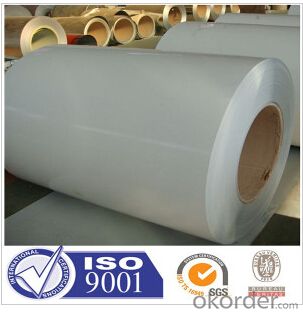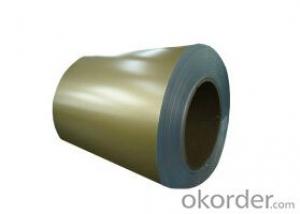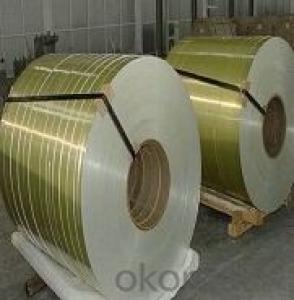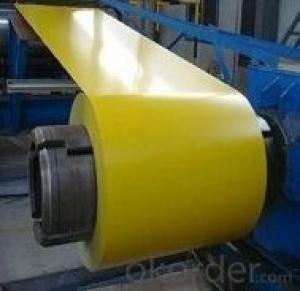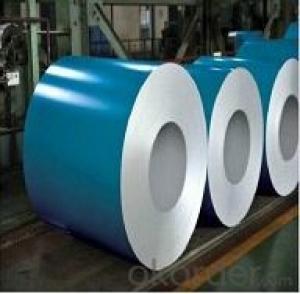0.12mm~1.3mm Prepainted Galvanized Steel Coil
- Loading Port:
- Shanghai
- Payment Terms:
- TT OR LC
- Min Order Qty:
- 25 m.t.
- Supply Capability:
- 10000 m.t./month
OKorder Service Pledge
OKorder Financial Service
You Might Also Like
Basic Info.
Model NO.:MLK-2015157
Surface Treatment:Coated
Certification:ISO, SGS, BV, RoHS, IBR
Technique:Cold Rolled
Standard:ASTM, JIS, GB, AISI, DIN, BS
Application:Construction Material
Edge:Mill
Stock:Stock
Steel Grade:Dx51d, SGCC, Sgch, A653, Dx52D, Dx53D
Place of Origin: China
Width:600mm-1500mm
Thickness:0.13mm-0.8mm
Length:Customered
Delivery Time:15-30 Days
Zinc Coating:30-275G/M2
Top Color Coating:10-25
Bottom Color Coating:7-10
ID:508mm
Export Markets:South America, Eastern Europe, Southeast Asia, Africa, Oceania, Mid East, Eastern Asia
Additional Info.
Trademark:MALIKE OR OEM
Packing:Standard Seaworthy, Export Packing
Standard:AISI, ASTM, BS, DIN, GB, JIS
Origin:Shandong, China
HS Code:7210700000
Production Capacity:700mt/Day
| NAME | GALVANIZED | GALVALUME/ALUZINC | PPGI/PPGL |
| MODEL NO. | (0.13-1.2)mm*(600-1250)mm | ||
| TYPE | steel coil, steel sheets/ plates, corrugated steel sheets/plates | ||
| TECHNIQUE | Hot rolled-cold rolled-galvanized | hot rolled-coldrolled-galvalume /Aluzinc | Hot rolled-cold rolled--galvalume/galvanized - PPGL/PPGI |
| SURFACE TREATMENT | Mini/regular/ big/zero spangle, ,Chromate treatment/ chromate-free treatment/ untreated Unoile/ oiled ,TENSION LEVELLERT SKIN PASS anti-fingerprint/Un-anti-fingerprint, coating | Polyester(PE),Silicone Modified(SMP),Acrylic (AC), Polyurethane(PU)PVC Plastisol(PVC plastisol can be embossed to versatile texture)etc | |
| APPLICATION | Guardrails, ventilation ducts, gutters and down spouts, Pre-paint and post paint applications, gutters and down spouts, ceiling suspension bars, shutter door rails. Auto parts, electrical appliances, refrigerator appliances, signs, automotive parts,vending machines, washing machines, showcases and other structural use, roofing, commercial use | Gutters, auto parts, electrical appliances, vending machines, refrigerators, ovens, for pre-paint. structural use, roofing, commercial use etc | Electrical appliances, roofing, partitions. Factory buildings, elevator panelsetc Special applications: wear resistant steel, high-strength-steel plate |
- Q: What is the maximum width of a steel coil?
- The maximum width of a steel coil can vary depending on the manufacturing process and the specific requirements of the industry. However, in general, steel coils can have a maximum width of around 2,200 millimeters (86.6 inches).
- Q: What are the different types of steel coil handling systems?
- There are several types of steel coil handling systems, including cradle systems, C-hook systems, coil grab systems, and coil transfer cars. These systems are designed to safely and efficiently handle steel coils of various sizes and weights in manufacturing and storage facilities.
- Q: How long can steel coils be stored before they need to be used?
- The storage duration for steel coils can vary depending on various factors such as the type of steel, environmental conditions, and proper storage techniques. However, generally, steel coils can be stored for an extended period, ranging from several months to a few years, as long as they are stored in a controlled environment to prevent corrosion and damage.
- Q: What are the factors influencing the price of steel coils?
- The price of steel coils can be influenced by a variety of factors. These factors include: 1. Raw material costs: The cost of raw materials, such as iron ore and coal, directly affects the price of steel coils. Fluctuations in commodity prices can have a significant impact on the overall price. 2. Supply and demand: The balance between supply and demand in the steel industry plays a crucial role in determining the price of steel coils. If there is high demand, prices are likely to increase. Conversely, if there is an oversupply, prices may decrease. 3. Production and manufacturing costs: The cost of producing and manufacturing steel coils, including labor, energy, and transportation costs, can also impact the final price. Any changes in these costs can influence the overall price. 4. Currency exchange rates: The price of steel coils can be affected by fluctuations in currency exchange rates. If the currency in which steel is traded weakens against other currencies, it can result in higher prices. 5. Government regulations and policies: Government regulations, such as import tariffs, export restrictions, and environmental regulations, can impact the price of steel coils. These regulations can affect the cost of production and trade, ultimately influencing the price. 6. Market competition: The level of competition among steel manufacturers and suppliers can also impact the price of steel coils. If there are many suppliers and manufacturers, it can lead to competitive pricing and potentially lower prices. Conversely, if there are few suppliers dominating the market, prices may be higher. It is important to consider that these factors can vary over time and in different regions, which ultimately affects the pricing of steel coils in the market.
- Q: How are steel coils used in the manufacturing of industrial machinery?
- Steel coils are commonly used in the manufacturing of industrial machinery to form various components, such as shafts, gears, and frames. These coils are typically cut, shaped, and welded into the desired forms to create strong and durable parts that can withstand heavy loads and high temperatures. Additionally, steel coils are often used as raw materials for fabricating machine tools, molds, and dies, which are essential for the production of industrial machinery.
- Q: How are steel coils inspected for formability?
- Steel coils are typically inspected for formability through a combination of visual inspection, mechanical testing, and laboratory analysis. Visual inspection involves examining the surface of the coil for any visible defects such as scratches, dents, or deformities that could affect its formability. This is usually done by trained personnel who carefully inspect the entire surface of the coil. Mechanical testing is also commonly employed to assess the formability of steel coils. This can include conducting physical tests such as tensile testing, where a sample is subjected to controlled forces to measure its strength and elongation properties. This helps determine if the steel has the necessary ductility and strength to be formed into the desired shape without cracking or breaking. Additionally, laboratory analysis is often conducted to assess the chemical composition and microstructure of the steel. This involves taking small samples from the steel coil and analyzing them using techniques such as spectroscopy and microscopy. These analyses can provide valuable insights into the steel's composition, grain structure, and other characteristics that can impact its formability. Overall, a combination of visual inspection, mechanical testing, and laboratory analysis is used to ensure that steel coils meet the required formability standards. This comprehensive approach helps identify any potential issues or defects that could affect the performance and reliability of the steel when it is formed into its intended shape.
- Q: Is there any noticable or perceived difference between smoking out of a pipe with a brass screen and a stainless steel screen?
- Stainless Steel Pipe Screens
- Q: What are the different types of steel coil slitting knives?
- There are several different types of steel coil slitting knives, including circular slitting knives, straight slitting knives, and crush-cut slitting knives. These knives are used for precision cutting and slitting of steel coils into narrower strips or sheets. Circular slitting knives feature a circular shape with sharp edges, while straight slitting knives have a straight cutting edge. Crush-cut slitting knives have a unique design that allows them to crush and cut the material simultaneously. Each type of knife is used for specific applications and offers different advantages depending on the desired outcome.
- Q: How do steel coils contribute to earthquake resistance in structures?
- Steel coils contribute to earthquake resistance in structures by providing strength and flexibility. When used in the construction of buildings, steel coils can absorb and dissipate the energy generated by an earthquake, preventing it from causing significant damage. The high tensile strength of steel allows it to withstand the lateral forces and vibrations during an earthquake, ensuring the structural integrity of the building. Additionally, the ductility of steel allows it to bend and deform without breaking, further enhancing its ability to withstand seismic activity.
- Q: Can steel coils be coated with magnetic materials?
- Yes, steel coils can be coated with magnetic materials. The coating process typically involves applying a thin layer of magnetic material, such as nickel or zinc, to the surface of the steel coils. This coating enhances the magnetic properties of the steel, making it more suitable for specific applications that require magnetism.
Send your message to us
0.12mm~1.3mm Prepainted Galvanized Steel Coil
- Loading Port:
- Shanghai
- Payment Terms:
- TT OR LC
- Min Order Qty:
- 25 m.t.
- Supply Capability:
- 10000 m.t./month
OKorder Service Pledge
OKorder Financial Service
Similar products
Hot products
Hot Searches
Related keywords
